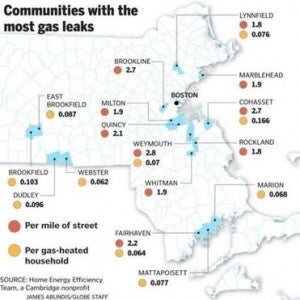New State Laws Seek to Improve Transparency in Utility Leak Management
A new Massachusetts law requiring gas utilities to annually report the location and age of known gas leaks has, for the first time, enabled the mapping of gas leaks from natural gas distribution  pipelines across the state. This effort parallels EDF’s methane mapping project, as part of which it is publishing maps of methane leaks from utility pipes in various U.S. cities, highlighting the scale of the problem and the need for thoughtful utility and regulatory responses.
pipelines across the state. This effort parallels EDF’s methane mapping project, as part of which it is publishing maps of methane leaks from utility pipes in various U.S. cities, highlighting the scale of the problem and the need for thoughtful utility and regulatory responses.
The issue is multidimensional. Gas leaks have both environmental and economic consequences, in addition to public safety implications. Most states only require utilities to address leaks that pose a present or future public safety threat. Other leaks can and do continue unabated for years, wasting gas and imposing an undue economic burden on ratepayers. The environmental implications are also serious. Methane, which is the primary constituent of natural gas, is a greenhouse gas, 84 times more potent than carbon dioxide over a 20-year timeframe.
Massachusetts is among the first states to adopt regulations responding to the problem, in part, by requiring utilities to be more transparent in their leak management efforts. Along similar lines, California passed a new law last year requiring utilities to report key information on gas leaks including leak management practices, open leaks being monitored/scheduled for repair and a best estimate of gas lost due to leaks. EDF is intervening in an ongoing proceeding before the California Public Utilities Commission to ensure the adoption of regulations that capture the legislation’s emphasis on improving transparency in utilities’ leak management efforts.
Enhancing transparency in utilities’ leak management efforts is critical to the endeavor to reduce methane emissions from natural gas distribution systems. Communities have the right to know about gas leaks from utility pipes that directly affect them. Requiring utilities to report data on gas leaks has tangible benefits too. It allows for better assessment of the associated risks and the scale of the problem, without which robust regulatory and utility responses cannot be designed. By allowing for utilities’ progress in reducing leak inventories to be measured, it also represents the first step toward greater accountability.
Since the launch of the EDF-Google methane mapping project, certain major utilities that EDF has been engaging with – including Consolidated Edison in New York, Southern California Gas Company, and San Diego Gas and Electric in California – have chosen to voluntarily develop and publish their own dynamic, public-facing maps of gas leaks from their pipes. None of these utilities are required by existing state or federal regulations to do so, making their efforts particularly noteworthy.
But to improve transparency in utility leak management efforts at scale, it is not enough to rely on the efforts of a few utilities. We need standards that create a level playing field for all players. Massachusetts and California have taken the lead. More states must follow.
Image Source: James Abundis, Boston Globe











